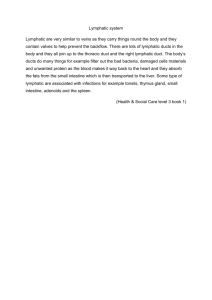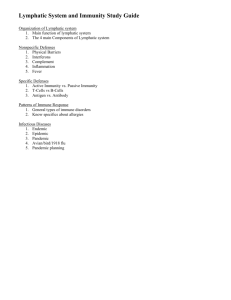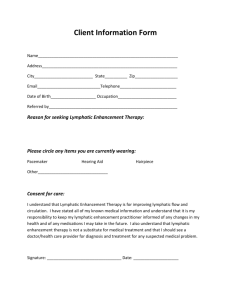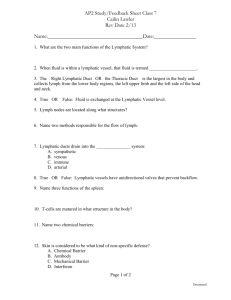2.03 Remember the structures of the lymphatic system
advertisement
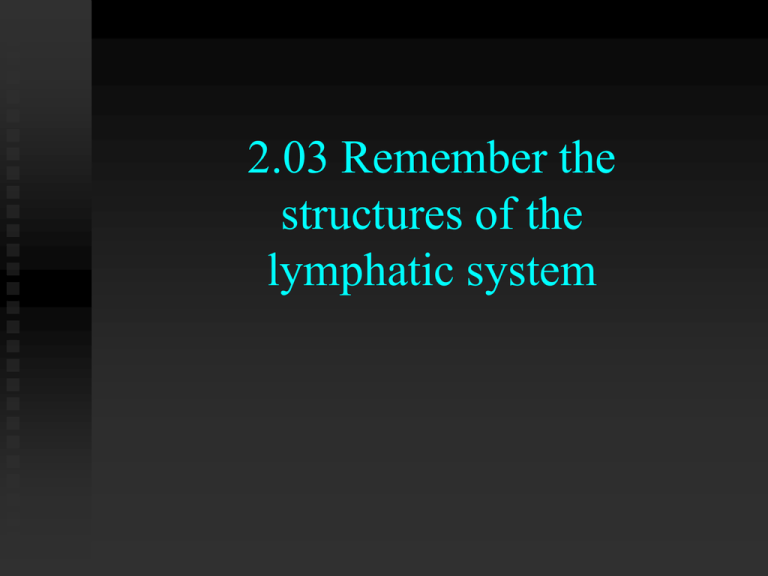
2.03 Remember the structures of the lymphatic system 2.03 Remember the structures of the lymphatic system What are the structures of the lymphatic system? 2.03 Remember the stuctures of the lymphatic system 2 Structures of the lymphatic system 2.03 Remember the stuctures of the lymphatic system 3 Lymph System is supplemental to circulatory system. Composed of lymph, lymph nodes, lymph vessels, the spleen, the thymus gland, lymphoid tissue in the intestinal tract, and the tonsils. System contains no pump. 2.03 Remember the stuctures of the lymphatic system 4 Structures of the lymphatic system Lymph fluid -Similar in composition to blood plasma 2.03 Remember the stuctures of the lymphatic system 5 LYMPH • Straw colored • Diffuses from the capillaries into tissue spaces • Fills surrounding spaces between tissue cells also referred to as intercellular, interstitial fluid, or tissue fluid • Composed of water, lymphocytes, oxygen, nutrients, hormones, salts, CO, and urea 2.03 Remember the stuctures of the lymphatic system 6 Structures of the lymphatic system Lymph vessels • Closely parallel the veins 2.03 Remember the structures of the lymphatic system 7 Vessels Located in almost all tissues and organs that have blood vessels Not found in cuticle, nails, or hair Capillaries are not found in cartilage, CNS, epidermis, eyeball, inner ear, or spleen Two main large lymphatics: thoracic duct and right lymphatic duct Only travels in one direction; from body organs to the heart 2.03 Remember the stuctures of the lymphatic system 8 Structures of the lymphatic system Lymph vessels parallel to blood vessels 2.03 Remember the stuctures of the lymphatic system 9 Structures of the lymphatic system Lymph vessels • Lacteals • Specialized lymph vessels in the small intestines 2.03 Remember the stuctures of the lymphatic system 10 Structures of the lymphatic system Lymph vessels • Lymphatic ducts • 2 Large lymph vessels • Thoracic duct • Also called the left lymphatic duct • receives lymph from the left side as pictured • Right lymphatic duct • Lymph flows only in one direction 2.03 Remember the stuctures of the lymphatic system 11 Structures of the lymphatic system Lymph nodes • tiny, oval-shaped structures • range in size from a pinhead to an almond Lymph node 2.03 Remember the stuctures of the lymphatic system 12 Structures of the lymphatic system Lymph nodes • Where are lymph nodes located? • Why are there so many? 2.03 Remember the stuctures of the lymphatic system 13 Structures of the lymphatic system Tonsils • • 3 pairs masses of lymphatic tissue 1. Palatine tonsils • sides of throat 2. Adenoids • upper throat 3. Lingual tonsils • back of tongue 2.03 Remember the stuctures of the lymphatic system 14 Structures of the lymphatic system Say “aahhh” Why this is helpful? 2.03 Remember the stuctures of the lymphatic system 15 Structures of the lymphatic system Spleen • Sac-like mass of lymphatic tissue • Located in the LUQ just below diaphragm • Stores large amount of RBC’s • Destroys and removes old RBC’s 2.03 Remember the stuctures of the lymphatic system 16 Structures of the lymphatic system Thymus gland • • • Located in the upper, anterior part of the thorax, above the heart. Produces lymphocytes Also an endocrine gland 2.03 Remember the stuctures of the lymphatic system 17 2.03 Remember the structures of the lymphatic system What are the structures of the lymphatic system? 2.03 Remember the stuctures of the lymphatic system 18 2.04 Understand the functions and disorders of the lymphatic system 2.04 Understand the functions and disorders of the lymphatic system What are the functions of the lymphatic system? What is the importance of the lymphatic system as it relates to immunity? How do you relate the body’s use of nutrients to the lymphatic system? What are some disorders of the lymphatic system and how are they treated? 2.04 Understand the functions and disorders of the lymphatic system 20 The Lymphatic System What are the functions of the lymphatic system? 1 Lymph Fluid? 2 Lymph vessels? 3 Lymph nodes? 4 Spleen? (4 things) 5 Thymus gland 2.04 Understand the functions and disorders of the lymphatic system 21 The Lymphatic System Fluid balance Why is this important? What happens during this process? What is the relevance to health? What system helps with this? ____ Fluid IN 2.04 Understand the functions and disorders of the lymphatic system ____ Fluid OUT 22 The Lymphatic System Fluid Balance Lymph Vessels : transport excess fluid back to ------- system? Lymph Nodes : filter out harmful bacteria 2.04 Understand the functions and disorders of the lymphatic system 23 The Lymphatic System Lymphocyte production What are lymphocytes? What do they do? What is their relevance to health? 2.04 Understand the functions and disorders of the lymphatic system 24 Lymphocyte : type of leukocyte. They responsible for immune responses. There are two main types of lymphocytes: B cells and T cells. What do they do? Health relevance? STRUCTURES: Lymph nodes, Spleen, and Thymus gland all produce lymphocytes. 2.04 Understand the functions and disorders of the lymphatic system 25 The Lymphatic System Filtration What does a filter do? How do filters relate to the lymphatic system? 2.04 Understand the functions and disorders of the lymphatic system 26 Functions: Lymph Fluid: Intermediary between blood in capillaries and tissues 2.04 Understand the functions and disorders of the lymphatic system 27 Function: Lymph Vessels: Transport fluid 2.04 Understand the functions and disorders of the lymphatic system 28 Function: Lymph Nodes: Produce lymphocytes Filter out harmful bacteria 2.04 Understand the functions and disorders of the lymphatic system 29 Function: Spleen: Produce lymphocytes and monocytes Reservoir for blood in case of emergency Recycling plant for RBC’s; preserving hemoglobin 2.04 Understand the functions and disorders of the lymphatic system 30 Function: Thymus Gland: Produces T-lymphocytes 2.04 Understand the functions and disorders of the lymphatic system 31 The Lymphatic System Immunity ___________________ ___________________ ___________________ Natural Immunity _______________________ _______________________ _______________________ _______________________ _______________________ Immunity Notes Handout Acquired Immunity _____________________ _____________________ _____________________ _____________________ _____________________ Passive Acquired Immunity ____________________________ ____________________________ ____________________________ ____________________________ ________ Active Acquired Immunity ____________________________ ____________________________ ____________________________ ____________________________ __________________________ Natural Acquired Immunity ____________________________ ____________________________ ____________________________ ____________________________ ____________________________ 2.04 Understand the functions and disorders of the lymphatic system Artificial Acquired Immunity ____________________________ ____________________________ ____________________________ ____________________________ ______________ 32 The Lymphatic System Immunity What is immunity? Immunity – the body’s ability to resist pathogens and foreign materials - two general types – natural and acquired. 2.04 Understand the functions and disorders of the lymphatic system 33 The Lymphatic System Natural immunity : NATURAL IMMUNITY (Innate) – at birth, inherited and permanent. Includes anatomical barriers: Unbroken skin Mucus and tears Blood phagocytes Understand the functions and Local inflammation 2.04 disorders of the lymphatic system • • • • 34 The Lymphatic System Natural immunity Discuss the body’s natural immune processes seen in this picture. 2.04 Understand the functions and disorders of the lymphatic system 35 The Lymphatic System Acquired immunity: Active NATURAL ACQUIRED IMMUNITY result of having had and recovered from a disease. Immune cells “learn” and change each time they are engaged…exposed to pathogen. 2.04 Understand the functions and disorders of the lymphatic system 36 The Lymphatic System Acquired immunity: Passive Natural – baby gets from mother’s placenta or mother’s milk Artificial – Serum from another; immunoglobulin; antitoxin…lasts only 3-5 weeks…used when exposed to pathogen (i.e. measles, tetanus, hepatitis, etc.) 2.04 Understand the functions and disorders of the lymphatic system 37 How Ebola Blood Transfusions Work NBC News.com 2.04 Understand the functions and disorders of the lymphatic system 38 The Lymphatic System Acquired immunity Active Artificial Should immunizations be required? Why or why not? 2.04 Understand the functions and disorders of the lymphatic system 39 The Lymphatic System REVIEW What are the functions of the lymphatic system? 1 2 3 4 5 How are these functions relevant to health? 2.04 Understand the functions and disorders of the lymphatic system 40 Lymphatic System Disorders 2.04 Understand the functions and disorders of the lymphatic system 41 The Lymphatic System Tonsillitis What are the symptoms? What are the usual treatments? Why would you have your tonsils removed? 2.04 Understand the functions and disorders of the lymphatic system 42 Tonsillitis • • In childhood, they may become infected, enlarged, and cause difficulty swallowing Surgery done in extreme cases 2.04 Understand the functions and disorders of the lymphatic system 43 The Lymphatic System Lymphadenitis What is it? Lymph aden itis What are the symptoms? How is it treated? 2.04 Understand the functions and disorders of the lymphatic system 44 Enlargement of Lymph Nodes Term “swollen glands” used frequently Occurs when an infection is present and the body is attempting to fight the infection. LYMPHADENITIS – enlargement of the lymph nodes, occurs when infection is present and body is attempting to fight off the infection – generalized enlargement 2.04 Understand the functions and disorders of the lymphatic system 45 The Lymphatic System Hodgkin’s disease What is Hodgkin’s disease? What are the symptoms? How is it treated? Who is most likely to develop Hodgkin’s disease? 2.04 Understand the functions and disorders of the lymphatic system 46 HODGKIN’S DISEASE cancer of the lymph nodes painless swelling of lymph nodes is an early symptom; along with fever, chills, night sweats, and unexplained weight loss. Rx – chemotherapy and radiation Most commonly found in ages 20- 30. 2.04 Understand the functions and disorders of the lymphatic system 47 The Lymphatic System Infectious mononucleosis What is mononucleosis most often called? What causes it? How is it treated? 2.04 Understand the functions and disorders of the lymphatic system 48 INFECTIOUS MONONUCLEOSIS • Caused by virus • Frequently in young adults and children • Spread by oral contact ( i.e. kissing, drinking after someone) • Symptoms – enlarged lymph nodes and spleen, fever, physical and mental fatigue, Leukocytes • Rx – bedrest, symptomatic treatment 2.04 Understand the functions and disorders of the lymphatic system 49 Autoimmunity When a person’s own immune system mistakenly targets the normal cells, tissues, and organs of a person’s own body. This is known as an autoimmune disorder. 2.04 Understand the functions and disorders of the lymphatic system 50 Autoimmune Diseases Multiple Sclerosis Myasthenia Gravis Pernicious Anemia Psoriasis Crohn’s Disease Ulcerative Colitis Type I Diabetes Mellitus Rheumatoid arthritis Lupus Scleroderma 51 The Lymphatic System Lupus erythematosus What is the classic symptom of lupus? What other symptoms might present? How is lupus managed? What is the prognosis? 2.04 Understand the functions and disorders of the lymphatic system 52 Lupus Chronic inflammatory autoimmune disease. Experience profound fatigue, rashes, and joint pains. Common identifying rash: butterfly rash across nose and checks. Severe cases, immune system may attack kidney, brain, blood, or lung. Symptoms and damage controlled with antiinflammatory and symptomatic prescribed medications. 2.04 Understand the functions and 53 disorders of the lymphatic system The Lymphatic System Scleroderma What is it? What causes it? What are some complications of scleroderma? How is it treated? 2.04 Understand the functions and disorders of the lymphatic system 54 Scleroderma Thickening of skin and blood vessels. 95% of patients have Raynaud’s; spasm of the blood vessels in fingers and toes. Can result in loss of movement and dyspnea 2.04 Understand the functions and disorders of the lymphatic system 55 Hypersensitivity Body fails to protect itself against foreign material. Allergic reaction An ALLERGEN is an antigen that causes allergic responses. 2.04 Understand the functions and disorders of the lymphatic system 56 The Lymphatic System Anaphylactic shock What is it? What happens to these body systems? Nervous system Digestive system Respiratory system Integumentary system What is the treatment? 2.04 Understand the functions and disorders of the lymphatic system 57 Anaphylactic shock or Anaphylaxis Result of antigen – antibody reaction that stimulates massive secretion of histamines. Patient can experience breathing problems, headache, facial swelling, falling blood pressure, stomach cramps, and vomiting. Antidote: adrenaline and/or antihistimine 2.04 Understand the functions and disorders of the lymphatic system 58 The Lymphatic System AIDS How is it diagnosed? What do these terms mean? HIV ARC AIDS 2.04 Understand the functions and disorders of the lymphatic system 59 The Lymphatic System Acquired Immunodeficiency Disease Syndrome (AIDS) How is it transmitted? What is the incubation period? What are the symptoms? 2.04 Understand the functions and disorders of the lymphatic system 60 AIDS • Most severe type if HIV infection – spread through sexual contact and contact with bodily fluids (i.e. sharing needles) • Subject to OPPORTUNISTIC INFECTIONS – a healthy person would fight off these infections, but a person with AIDS has a compromised or impaired immune response. 2.04 Understand the functions and disorders of the lymphatic system 61 Symptoms of AIDS 1. 2. 3. 4. 5. 6. 7. 8. 9. 10. Prolonged fatigue Persistent fevers or night sweats Persistent, unexplained cough Thick coating in throat or on tongue Easy bruising, unexplained bleeding Appearance of purple lesions on mucous membranes or skin that don’t go away Chronic diarrhea Shortness of breath Unexplained lymphadenopathy Unexplained weight loss, 10lbs or more, in less than 2 months 2 Incubation period: 1 month to 12 years 62 AIDS-RELATED COMPLEX (ARC) • • • Has HIV but not have AIDS and may develop other conditions such as: Chronic Diarrhea Chronic lymphadenopathy Unexplained weight loss If life threatening opportunistic infections develop, then individual is said to have AIDS 63 ASYMPTOMATIC INFECTION – Has HIV but no symptoms. High-Risk Groups for AIDS – EVERYONE who participates in risky behaviors. Transmission by: Sex with someone who is HIV positive Sharing needles with infected IV drug users At birth from infected mother 1. 2. 3. 64 1. 2. 3. 1. 2. Cannot be spread by: Casual contact Through air, feces, food, urine or water Coughing, sneezing, embracing, shaking hands and sharing eating utensils Prevention: Avoid risky behaviors Standard precautions 2.04 Understand the functions and disorders of the lymphatic system 65 The Lymphatic System Lymphedema What is it? What causes it? How is it treated? Photo used with written permission by the Mayo Clinic. 2.04 Understand the functions and disorders of the lymphatic system 66 Lymphedema condition in which lymph fluid builds up in tissues Causes include: infection, cancer scar tissue from radiation therapy or surgical removal of lymph nodes, and inherited conditions in which lymph nodes or vessels are absent or abnormal. Treatment can help control symptoms. It includes exercise, compression devices, skin care, and massage 2.04 Understand the functions and disorders of the lymphatic system 67 2.04 Understand the functions and disorders of the lymphatic system 68 2.04 Understand the functions and disorders of the lymphatic system 69 2.04 Understand the functions and disorders of the lymphatic system 70 2.04 Understand the functions and disorders of the lymphatic system What are the functions of the lymphatic system? What is the importance of the lymphatic system as it relates to immunity? How do you relate the body’s use of nutrients to the lymphatic system? What are some disorders of the lymphatic system and how are they treated? 2.04 Understand the functions and disorders of the lymphatic system 71
